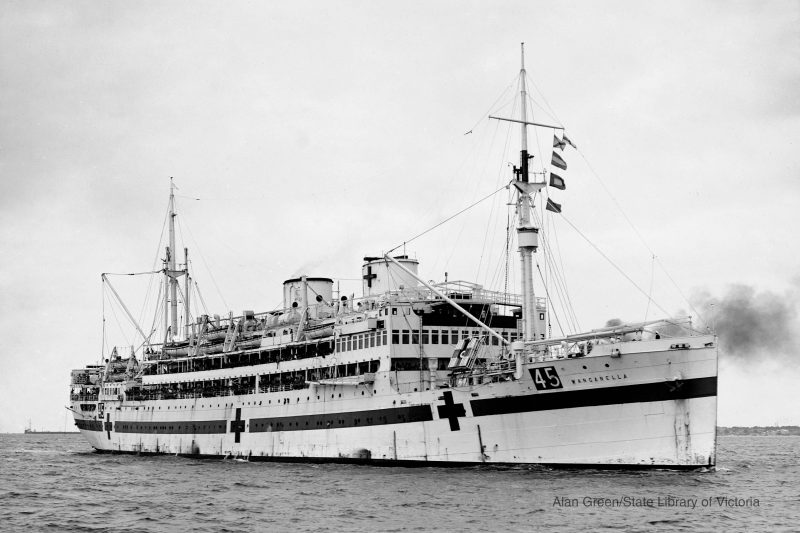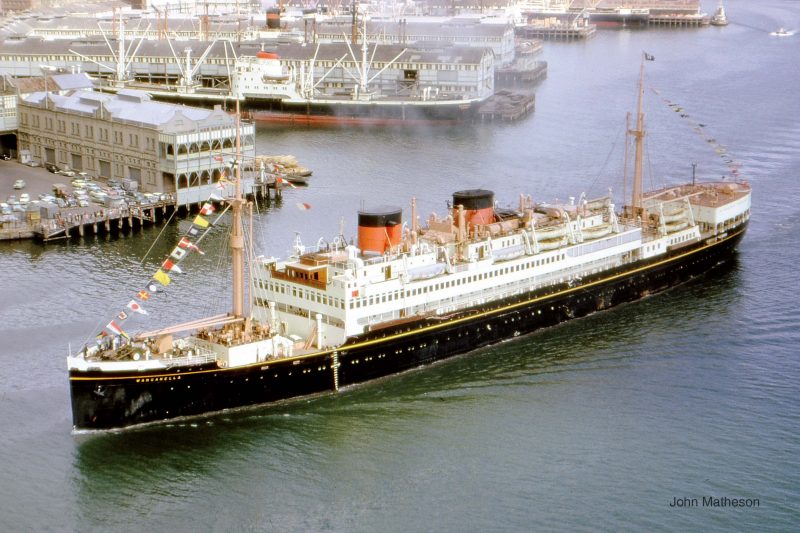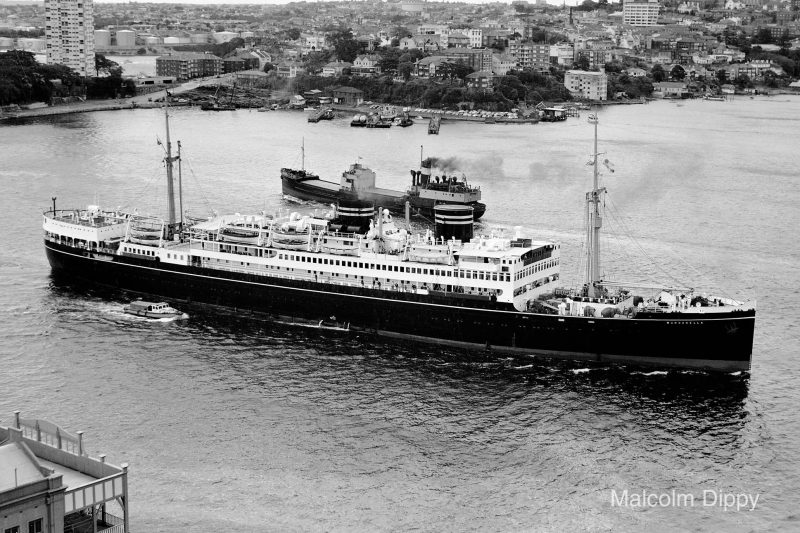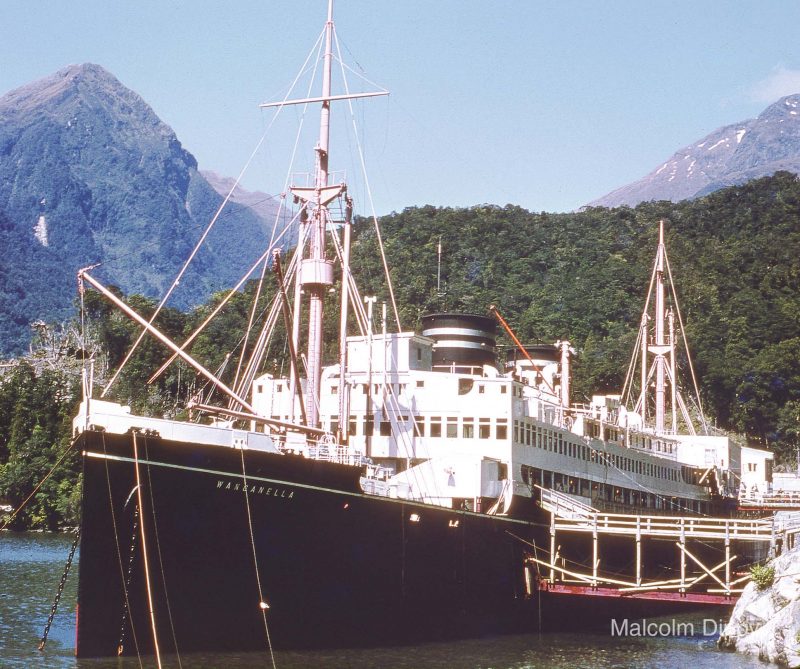The Famous Australian Liner and Hospital Ship

 Wanganella was a very special Australian liner built in 1929 and owned by Huddart, Parker Ltd. of Melbourne that gave 41 years of service, mostly on the Trans Tasman passenger services of her owners, but also on five years of hospital ship service to Singapore, India, New Guinea, the Solomons and the Mediterranean. She evacuated wounded British and New Zealand troops from the beach head at Anzio in central Italy not far from the terrible battles of Monte Cassino, where German armoured divisions clashed with American and British armoured divisions in bitter fighting. She resumed her peace time Trans Tasman service in 1946, serving until 27th October 1961 when taken over by McIlwraith, McEachearn Ltd. of Melbourne, with her twin yellow funnels then painted red. However, within a year she was sold to Hong Kong owners, with her funnel colours changed again to black with two silver bands, and she was to complete the final nine years of her career with these funnel colours.
Wanganella was a very special Australian liner built in 1929 and owned by Huddart, Parker Ltd. of Melbourne that gave 41 years of service, mostly on the Trans Tasman passenger services of her owners, but also on five years of hospital ship service to Singapore, India, New Guinea, the Solomons and the Mediterranean. She evacuated wounded British and New Zealand troops from the beach head at Anzio in central Italy not far from the terrible battles of Monte Cassino, where German armoured divisions clashed with American and British armoured divisions in bitter fighting. She resumed her peace time Trans Tasman service in 1946, serving until 27th October 1961 when taken over by McIlwraith, McEachearn Ltd. of Melbourne, with her twin yellow funnels then painted red. However, within a year she was sold to Hong Kong owners, with her funnel colours changed again to black with two silver bands, and she was to complete the final nine years of her career with these funnel colours.
Huddart, Parker Ltd.

This Melbourne shipping company traded from offices in Geelong and Melbourne for almost ninety years from its formation on 1st August 1876 by James Huddart, his nephew T. J. Parker, John Traill and Capt. T. Webb. The services operated including passenger and cargo services on the Australian coast e.g. Melbourne to Hobart, Adelaide and Sydney and later to other ports in Tasmania and Western Australia. Coastal colliers of up 6,500 dwt were built for the trades around Australia and encountered little competition, unlike the passenger services that went head to head with the Union Steamship Company of New Zealand (USSNZ) and the Tasmanian Steam Navigation Company. The bitterly contested intense competition saw the Tasmanian Steam Navigation Company taken over by USSNZ, with the rivalry between Huddart, Parker and USSNZ temporarily halted in 1895 by a profit sharing agreement. The Bass Strait passenger services were then operated jointly from 1921 by a new company Tasmanian Steamers Pty Ltd. with 50% shareholding to each company.
Notable Huddart, Parker Ltd. steamers down the years included the twin funnelled Alert of 243 grt built in 1877 but sunk off Port Phillip Heads in 1893 with the loss of fifteen lives. Coogee of 762 grt was purchased in 1888 for the Bass Strait trade after completion on the Wear during the previous year, and was later chartered as a cable repair ship in the Bass Strait from 1921. Nelson of 649 grt was purchased in 1890 but sank on her first voyage for the company at the mouth of the Tamar river. The Trans Tasman passenger steamer built in 1887 as Elingamite of 2,585 grt sank to the north of New Zealand in 1902 with the loss of 45 lives as well as a large amount of gold bullion. Zealandia of 6,600 grt was a notable passenger liner with accommodation for 426 passengers in three classes and a product of the John Brown yard at Clydebank in 1910. She served as a troopship in both World Wars until sunk by the Japanese bombing of Darwin on 19th February 1942. Ulimaroa of 5,777 grt was a passenger liner from the Gourlay Brothers yard in Dundee in 1908 for the Trans Tasman service sailing between Sydney, Melbourne and Hobart to New Zealand ports with accommodation for 430 passengers in three classes until broken up in Japan in 1934.
A new Huddart, Parker passenger liner was launched as Westralia at the Govan yard of Harland & Wolff Ltd. on 25th April 1929 and completed four months later with accommodation for 433 passengers in two classes, as well as carrying 6,265 tonnes of general and refrigerated cargo. The directors of Huddart, Parker Ltd. wished to have a replacement on the Trans Tasman passenger services for Ulimaroa and a partner for Westralia, and their search ended when a new twin funnelled passenger liner was found laid up at the Belfast yard of Harland & Wolff Ltd. in the summer of 1932 due to the financial crash of the Royal Mail Line group of companies.
Design and Specification of Wanagnella
Wanganella was launched on 17th December 1929 at Belfast as Achimota for the British and African Steam Navigation Company, and managed by Elder Dempster, a group member of Royal Mail Lines. The coastal cargo ship carrying her twin diesel engines from the Glasgow engine works of Harland & Wolff Ltd. sank during 1930, and the engine replacements saw the delivery of the new liner severely delayed. She was completed in Septem-ber 1931 with a grey hull and two yellow funnels, but due to the collapse of Royal Mail Lines after the financial irregularities and trial of Lord Kylsant, the final large instalment of £300,000 could not be paid.
It was first thought that she should be hired to Elder Dempster, but the creditors refused since her brand new value was greater than the likely return on capital allied to second hand value. It was also thought that Elder Dempster would emerge with the capability to complete the purchase. The total cost of the ship was £520,000 and her building costs were only recouped when the directors of Huddart, Parker Ltd. agreed to pay £346,376 as a final bargain price. The cost included a dry docking and alterations after her long year in lay up as the new owners wanted a larger passenger complement of 408 passengers in two classes instead of the 324 passengers in three classes plus deck passengers for the West African trade of Elder Dempster.
The directors of Huddart, Parker Ltd. were present on the bridge of the new ship on her second set of two sea trials, still named Achimota, and all went well and the liner sailed from Belfast Lough on 29th November 1932 under the command of Capt. Bates, formerly Master of Westralia, bound for Sydney via Suez, and on arrival she was renamed Wanganella and was given a black hull with a white line and retained her yellow funnels. Wanganella was to serve a fortnightly service alternating between Sydney to Melbourne and Wellington, and between Melbourne and Auckland. The passenger accommodation extended over four decks, namely from the top working downwards in the Promenade Deck, ‘A’ Deck or Bridge Deck, ‘B’ Deck or Upper Deck, ‘C’ Deck or Main Deck, with a Sun Deck on the Boat Deck above the Promenade Deck for games and open space use.
Wanganella had a straight stem, cruiser stern semi-balanced rudder, two slightly raked funnels, and two very tall masts which gave her the characteristic of similar Royal Mail Line liners of the 1920s. She was in effect a scaled down version of the liners Asturias and Alcantara completed at Belfast in 1926/27, and her profile instantly recognised her as a traditional British designed motorship. Seven transverse bulkheads divided the ship into eight compartments, and there were three complete steel decks in her hull, as well as a combined fo’c’stle, bridge deck and poop. Oil fuel, fresh water and water ballast were carried in her double bottom tanks, with cargo in four holds, two forward and two aft of the machinery spaces. Refrigerated cargo and food for passenger and crew consumption was carried in spaces forward of the machinery and below the lower deck.
The principal dimension of the vessel were overall length of 479.0 feet, moulded beam of 63.6 feet, depth to Upper Deck of 34.6 feet, and loaded draft of 24.6 feet. The fo’c’stle was of length 53 feet, the Bridge Deck of length 276 feet, and the poop of length 38 feet. Wanganella was measured at 9,876 grt and could carry 6,238 tonnes of cargo in four holds and worked by derricks on her two tall masts. She carried sixteen lifeboats with double banked boats arranged around the after holds. The very tall foremast had a large crow’s nest half way up, and together with the mainmast had crosstrees, and both could fly long signal hoists from their tops when dressed overall. The navigating bridge was equipped with the latest navigational equipment, and the radio room and accommodation for the Master and navigating officers was abaft the bridge and in the structure below the twin funnels.
Public rooms of Wanganella

The First Class Main Lounge was forward on Promenade Deck and was finished with fine timber panelling with Grecian style carved pillars as supports, tall French windows opening on to the deck on three sides, and a central area with a high dome reaching up to Boat Deck. Large comfortable armchairs and sofas had grey fabric finishes, and the windows were offset by elegant columns on both sides with cool blue or grey curtains draped to the side. On the outer forward side of the room a large traditional fireplace gave some heat generated by electricity if the temperature in the Tasman Sea dropped significantly.
The First Class Reading and Writing Room was immediately abaft this lounge and was lined with grey wood panels, and abaft of this was a Second Lounge in a much lighter Italian style with twinned windows, wall lights, tables and carver chairs with intricately carved backs, and white sofas and easy chairs. At the aft end of Promenade Deck was the First Class Smoking Lounge in a dark wood and velvet wallpapered Spanish style, for gentlemen sitting around heavy wood tables and leather backed carver armchairs. The floor was inlaid with several layers of marble, and the rear part of the room overlooked the Verandah Cafe and the aft decks.
The First Class Dining Room was two decks below forward on Main Deck and was a grand rectangular double height room with a huge central cross vaulted dome, double curved lattice windows, and concealed lighting in the upper area behind groups of five adjacent small glass covers. Thirty numbered tables were set for eight, six or four guests, with the larger tables in the middle, and the smaller tables on the sides near the windows and in between the supporting pillars. The children’s playroom was entered from the forward end of the Dining Room. The First Class Staterooms were ‘midships on Upper Deck, with a lesser number on Main Deck, and were luxurious twin bedded cabins that converted into a lounge during the day. In addition, there were a number of First Class Suites with a higher standard of comfort.
The Second Class Main Lounge was on ‘A’ (Bridge Deck) and was finished in old oak and plasterwork, and was adjacent to the Second Class Entrance, Card Room, Games Room and Library. These rooms were smaller in area than their equivalent in First Class, with the Second Class Dining Room finished in modern colourful tones and cheerful for the three and one half day crossing of the Tasman Sea.
Main Propelling and Auxiliary Machinery
Wanganella was twin screw and propelled by two sets of eight cylinder single acting four stroke cycle Harland-B. & W. air injection diesel engines of 8,500 bhp at 108 rpm to give a service speed of seventeen knots. The engines were continuously supercharged on The Italian Buchi system by means of Brown-Boveri turbo-blowers driven by the main engine exhaust and discharging directly into the inlet manifold. The main engines each drove their own air injection compressor from an extension of the forward end of the crankshaft. The pistons were cooled by oil, with the cylinders, covers and jackets cooled by fresh water. The superchargers were located at the forward end of the engine room on the port and starboard sides.


The three 250 kilowatt diesel driven generators were also located at the forward end of the engine room, and were six cylinder four stroke cycle air injection diesel engines built at Belfast by the shipbuilder. These were equipped with oversize compressors, which in addition to starting the engines supplied the necessary air for manoeuvring. The air was stored in four large reservoirs, arranged two on each side near the bedplates of the engine. The three generators supplied the electric current for the lighting, heating and power of the vessel. There was also an emergency plant, consisting of a 50 kilowatt diesel driven generator for use at any time that the main generators were out of action. The main switchboard was at the forward end of the machinery spaces above the generators. The engine room also contained two 300 gallon centrifugal purifiers for dealing with the lubricating oil. The main engines exhausted into separate silencers or to a thimble tube exhaust gas boiler for use in port, and were arranged in the casing leading to the aft funnel, the forward funnel being a dummy. The upper decks were thus only interrupted by a very small trunkway, resulting in more space for the passengers in their staterooms and public rooms. The engine room was very compact, occupying 34 frames spaces of the hull, but there was plenty of room for engine repairs and overhauls. All of the deck equipment such as windlass, cargo winches, steering gear, pumps and the twin Hall carbon dioxide refrigerating machines were electrically driven.
Career of Wanganella
Wanganella was named after a small village in the Billabong Creek on the Cobb Highway in southern New South Wales. Twelve days after her arrival at Sydney from Belfast on the last day of 1932 after a fast voyage from Belfast of only 29 days and 22 hours, Wanganella was ready for her maiden voyage across the Tasman Sea from Sydney via Melbourne to Auckland and Wellington and return to Sydney. The 12th January 1933 sailing heralded the start of a Huddart, Parker Ltd. Trans Tasman Express service with her earlier near sister of Westralia, and Zealandia built in 1910. On this maiden sailing, Wanganella showed herself off to some of those living on the South Island of New Zealand by sailing down the west coast to the Fjordlands of South Island and then sailed up the majestic Milford Sound with its high mountain peaks. Wanganella always berthed at an adjacent dock in Darling Harbour in Sydney from the USSNZ berth, with their twin funnelled Trans Tasman flyer of the distinctive counter stern of Monowai of 11,037 grt dating from 1925 and their other passenger liners, waiting to compete with Wanganella, Westralia and Zealandia.
The outbreak of war in Europe on 3rd September 1939 had little impact in the Antipodes until the ANZAC troop forces of Australia and New Zealand were mobilised and took ship to the Middle East. However, the arrival of the German raider Orion, the former Kurmak of Hapag, in the waters of the South Pacific in June 1940 saw her lay long lines of mines across the sealanes to the north of New Zealand. The USSNZ liner Niagara entered Hauraki Gulf during the night of 19th June and struck one of these mines at 0300 hours and settled by the head during the next two hours and sank at 0530 hours. Wanganella took on board her 136 passengers and 205 crew members, and took them safely to Auckland. Three minesweepers plus the cargo-liner Port Bowen of Port Line and Baltannic of United Baltic Corporation were lost before the sea lanes were declared safe again.
Wanganella was converted in Melbourne in April, May and June of 1941 into a hospital ship and given a white hull with a broad red band interrupted by Red Crosses at intervals on both sides of her hull and on her stern and both sides of her twin funnels. She was fully operational and complete with operating theatres, medical equipment and staffed by fully trained surgeons and nurses. She had beds for 434 patients, which was increased to 550 patients in 1943, and carried a medical staff of 110 from the Royal Australian Army Medical Corps, as well as 123 crew members. She sailed from Melbourne as HMAHS Wanganella on 21st July 1941 after her commissioning ceremony earlier that day for Singapore via Sydney. She carried several Australian General Hospital (A.G.H.) units to Singapore, and returned with Australian troops that had fallen foul of tropical diseases, together with 216 civilians and Government representatives.

Wanganella served as the Australian Hospital Ship 45 in many war theatres of the world, and survived bombings and machine gunning from German planes. The first voyage to Suez to load and treat British wounded troops from the Egyptian campaign saw her bombed at Port Tewfik. The Japanese thrusts into the Pacific from the Philippines and the savage fighting in Papua New Guinea and the Solomons meant that Wanganella often loaded her wounded at open anchorages in the Solomons and off Papua New Guinea as well as at Port Moresby. She made several voyages from Suez to Australian ports with wounded troops, and in mid-November 1942 on one of these voyages she took onboard several wounded men from the Dutch Shell tanker Ondina when 200 miles north west of Fremantle. Blood transfusions were needed by some of the wounded to save their lives, as their tanker had been very badly damaged by shells from the Japanese raiders Aitoku Maru and Hokoku Maru. This pair were converted OSK passenger and cargo liners, but justice was done when shells from the after gun of Ondina and her escorting corvette Bengal caused a direct hit and masses of flames on Hokoku Maru, which sank with the loss of much life.
On 14th April 1944, Wanganella was at anchor off Bombay when the terrible ammunition explosion onboard the standard cargo ship Fort Stikine ripped through Bombay Docks, sinking many ships and causing a gruesome loss of life. The local hospitals were overcome by the rush of badly injured people, and Wanganella was asked to help. The medical team treated many people with serious burns and wounds over the course of one week, with the surgical team working without a break. After all had been cared for and were on the mend, Wanganella discharged her patients and sailed for the Mediterranean. In late May 1944, after Wanganella loaded her badly wounded troops at the Anzio beach head, they were cared for by her medical teams until she arrived at Wellington and Lyttelton, and she then returned to Sydney in June 1944 to berth at the main passenger berth of Circular Quay under the famed Sydney Harbour Bridge.
After the Japanese were cleared out of Borneo, Wanganella was sent on two voyages to Kuching, Labuan and Balikpapan to take onboard and repatriate Australian prisoners of war, part of the two thousand men that had been interned by the Japanese on the island, and she transported them to Morotai Island in the northern group of Dutch East Indies islands and then back to Sydney where she arrived on 23rd November 1945 to end her hospital ship service. There is a memorial to HMAHS Wanganella in a cemetery on St. Kilda Road in Melbourne to remember the many wounded troops she brought back home to Australia.
By the end of her hospital ship service in late 1945, Wanganella had cared for and treated 13,389 wounded and sick troops and evacuees, particularly Australian, New Zealand and American troops. She had sailed 252,000 nautical miles on these mercy missions, and needed a complete overhaul of nine months at Melbourne to restore her to commercial service condition. The opportunity was taken also to increase her passenger complement to 424 passengers from the previous total of 408 by fitting extra cabins at the rear end of ‘A’ (Bridge Deck), which was also glazed over, and by fitting a two deck structure on her poop for improved crew accommodation and facilities. Above on the First Class Promenade Deck, canvas covers could now be raised to give shelter from winds in gale force conditions. On completion of her refit in September 1946, Wanganella made a ‘one off’ voyage on the ‘All Red’ route to Vancouver from Sydney via Auckland and Honolulu, returning to Sydney on 28th December 1946.

Disaster on Barrett Reef at Wellington
Wanganella then made her first post-war Trans Tasman voyage from Sydney and Melbourne to Auckland in January 1947. In darkness on 19th January at 2330 hours, Commander R. Darroch mistook the channel marked by the flashing buoy in front of Barrett Reef on 19th January and took Wanganella on the inside of the buoy causing her to pile up on some nasty protruding rocks and become firmly wedged. She had two long, massive tears in her plating below the waterline at her bow, but thankfully no injuries were caused to her passengers and crew and all were safely taken off. The damage to her forefoot and forward double bottom tanks was massive as it took eighteen days for tugs to free her from her rocky predicament. An exceptional high tide with her engines at full astern and a very powerful tug named Toia towing at full power finally broke her free on 6th February and she was towed into the harbour and berthed at Aotea Quay just before midnight. She was placed into the Wellington Floating Dock for inspection, with the surveyors finding that she was very badly damaged indeed, and a new forepeak, forefoot and forward double bottom units weighing 400 tonnes would have be ordered from her builder at Belfast to make the necessary repairs.
The big repair job was able to get underway in the late summer of 1948 when the new sections arrived at Wellington from Belfast on cargo ships, and with Wanganella kept afloat during this long wait by compressor pumps at her berth or safely placed in dry dock. The top of the bow had to be propped up by steel supports to prevent sagging while the new steel sections were inserted below, and the repair was finally completed on 29th October 1948 under the supervision of a Harland & Wolff Assistant Works Manager. This remarkable piece of ship surgery and engineering enabled Wanganella to cheat the scrapyard and sail on for another 22 years until the end of her career. The USSNZ ferry Wahine was later wrecked on the Barrett Reef on 10th April 1968 with the loss of 51 lives.
The Final Years
Wanganella resumed her Trans Tasman service after sea trials in late November 1948, and sailed from Wellington to Sydney on 9th December 1948 after an absence in the Australian port of nearly two years. She also operated occasional cruises to the Southern Fjordlands of New Zealand and into the Pacific until a further refit in 1952 gave her a glazed in forward part of her Promenade Deck to better protect her First Class passengers in gale conditions. She had a successful cruise season in mid 1958 in the Southern Fjordlands of New Zealand and into the Pacific, while operating her Trans Tasman Express for the remainder of the year. However, passenger numbers were dropping from late 1959 due to air competition across the Tasman, and Huddart Parker Ltd. had to decide to offload their passenger division to McIlwraith, McEachearn Ltd. of Melbourne in the Autumn of 1961.

The twin yellow funnels of Wanganella were painted in the dark red colours of her new owners in Sydney on 27th October 1961 and she resumed her Trans Tasman services. Passenger numbers continued to drop over the following six months, but a shut down disabled port diesel engine at the end of March 1962 en-route to Auckland signalled that the end of her Trans Tasman service was nigh. She returned to Sydney on her starboard engine while the port engine was repaired, but a further engine explosion on 12th June 1962 while manoeuvring in Sydney harbour convinced her new Melbourne owners to offer her for sale. She was repaired again and made a last few weeks of service on her familiar Trans Tasman services until the last sailing returned to Sydney on 25th July 1962 under the command of Capt. William Uttley, her Master for many years. She was taken over by the Hang Fung Shipping Company of Hong Kong, and her twin funnels were now painted black with two central thin silver bands.
Wanganella then operated cruises from Auckland to the South Pacific and Australia for her Hong Kong owners, and was a hotel ship for the ‘Perth Empire Games’ (Commonwealth Games) at Perth in late 1962. The Pacific cruising ended in January 1964, but she was then sold to Utah Construction Inc. of America as an accommodation ship at Doubtful Sound at South Island in New Zealand, serving until the end of 1969. She was moored against a rocky shore with a permanent pedestrian connection for her workers to reach the hydro electric scheme tunnels and roads they were working on. Doubtful Sound is to the south of the more famous Milford Sound, and the hydroelectric scheme provided water power for the Manapouri Power Station commissioned in 1972 to supply electricity to Tiwai Point aluminium smelter near Bluff one hundred miles away. Wanganella was taken over by the New Zealand Government (Ministry of Works) when Utah Construction finished their part of the contract.

She was sold at the end of 1969 to the Australian Pacific Shipping Company of Hong Kong, but had been idle for six years and her twin diesel engines could not be restarted, so her last voyage was under tow to Hong Kong, where she was found not worthy of reconditioning. She was sold to a Kaohsiung scrapyard for breaking up, arriving on 5th June 1970, still as Wanganella. Towards the end of 1970 nothing remained at the Hong Kong scrapyard of Shyeh Sheng Fuat Steel and Iron Company to show that a very great Australian liner had ended her days there.



Comments
Sorry, comments are closed for this item